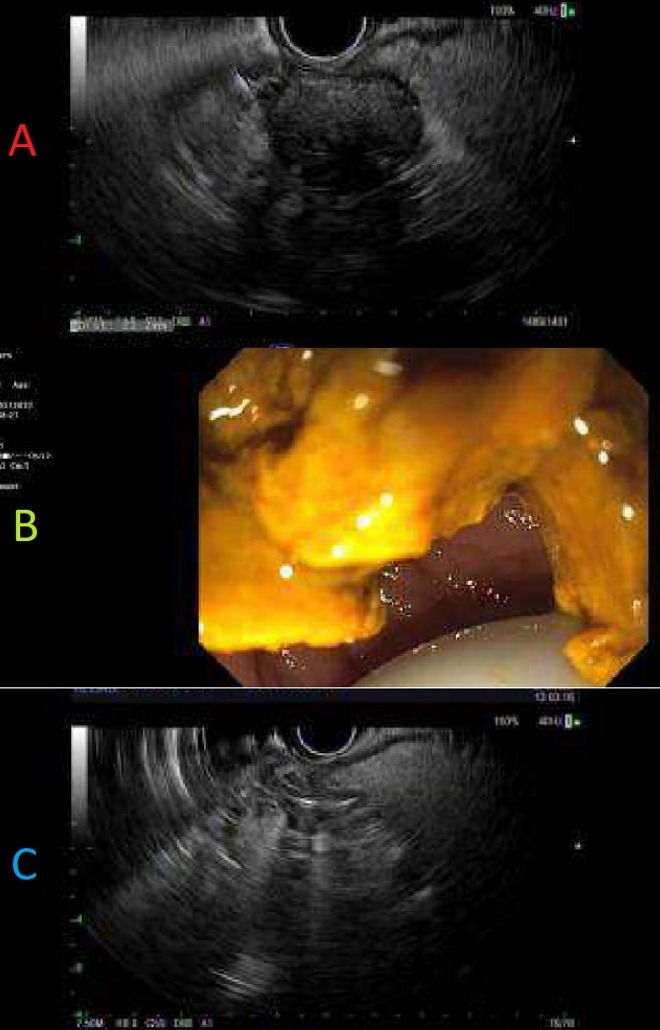Back


Poster Session A - Sunday Afternoon
Category: Interventional Endoscopy
A0442 - Compacted Periampullary Diverticulum Masquerading as Pancreatic Head Mass on Endoscopic Ultrasound
Sunday, October 23, 2022
5:00 PM – 7:00 PM ET
Location: Crown Ballroom

Has Audio

Pranay Reddy, MD, MPH
Jefferson Health Northeast
Philadelphia, PA
Presenting Author(s)
Pranay Reddy, MD, MPH1, David Valadez, MD2, Amit Rastogi, MD3, Richard Sutton, DO3, Charlie Altfillisch, MD4
1Jefferson Health Northeast, Philadelphia, PA; 2University of Kansas Medical Center, Kansas City, KS; 3Kansas University Medical Center, Kansas City, KS; 4University of Kansas Medical Center, Kansas City, MO
Introduction: Endoscopic ultrasound (EUS) has become an increasingly important modality in the diagnosis and treatment of gastrointestinal malignancy as well as both pancreatic and biliary disease. It provides high-resolution, real-time imaging of the GI tract and surrounding structures. EUS is classically operator dependent and can often display suboptimal sensitivity and specificity. Numerous techniques such as Endoscopic guided fine-needle aspiration (EUS-FNA), EUS fine needle biopsy (EUS-FNB), rapid on-site cytological evaluation (ROSE) and contrast harmonic-enhanced EUS (CH-EUS) help to increase the sensitivity and specificity of this diagnostic modality. The following case describes a patient with initial EUS findings concerning for pancreatic head malignancy which was ultimately identified as a periampullary diverticulum compacted with sludge.
Case Description/Methods: A 70-year-old patient with a past medical history of prostate cancer and cholelithiasis status post recent cholecystectomy presented with CT imaging findings concerning for pancreatic head mass. The patient underwent initial EGD with EUS which illustrated a well circumscribed, heterogeneously echoic 26.8 x 24 mm uncinate process mass concerning for neuroendocrine tumor (NET). FNB was performed and cytology ultimately showed no evidence of malignancy. Due to continued concern for pancreatic NET, patient underwent repeat EGD and EUS. EUS redemonstrated the large heterogeneously echoic pancreatic head lesion concerning for mass. Attempts were made to visualize the ampulla with linear EUS scope, however there was significant debris in the second portion of the duodenum. Duodenoscope was then passed and a large caliber but narrow opening periampullary diverticulum was visualized and appeared to be filled with compacted sludge. A combination of biopsy forceps and water lavage was used to clean out the compacted sludge. The EUS scope was then re-advanced into the second part of the duodenum and the suspected mass which was previously visualized was no longer visible.
Discussion: EUS is a an important, minimally invasive diagnostic procedure that has both high clinical success rate with relatively few adverse events. EUS, like many other diagnostic modalities, has limitations when identifying and ruling out malignancy. This case highlights one such limitation showing that although initial findings were concerning for malignancy, further investigation revealed a duodenal diverticulum with compacted debris masquerading as an uncinate mass.

Disclosures:
Pranay Reddy, MD, MPH1, David Valadez, MD2, Amit Rastogi, MD3, Richard Sutton, DO3, Charlie Altfillisch, MD4. A0442 - Compacted Periampullary Diverticulum Masquerading as Pancreatic Head Mass on Endoscopic Ultrasound, ACG 2022 Annual Scientific Meeting Abstracts. Charlotte, NC: American College of Gastroenterology.
1Jefferson Health Northeast, Philadelphia, PA; 2University of Kansas Medical Center, Kansas City, KS; 3Kansas University Medical Center, Kansas City, KS; 4University of Kansas Medical Center, Kansas City, MO
Introduction: Endoscopic ultrasound (EUS) has become an increasingly important modality in the diagnosis and treatment of gastrointestinal malignancy as well as both pancreatic and biliary disease. It provides high-resolution, real-time imaging of the GI tract and surrounding structures. EUS is classically operator dependent and can often display suboptimal sensitivity and specificity. Numerous techniques such as Endoscopic guided fine-needle aspiration (EUS-FNA), EUS fine needle biopsy (EUS-FNB), rapid on-site cytological evaluation (ROSE) and contrast harmonic-enhanced EUS (CH-EUS) help to increase the sensitivity and specificity of this diagnostic modality. The following case describes a patient with initial EUS findings concerning for pancreatic head malignancy which was ultimately identified as a periampullary diverticulum compacted with sludge.
Case Description/Methods: A 70-year-old patient with a past medical history of prostate cancer and cholelithiasis status post recent cholecystectomy presented with CT imaging findings concerning for pancreatic head mass. The patient underwent initial EGD with EUS which illustrated a well circumscribed, heterogeneously echoic 26.8 x 24 mm uncinate process mass concerning for neuroendocrine tumor (NET). FNB was performed and cytology ultimately showed no evidence of malignancy. Due to continued concern for pancreatic NET, patient underwent repeat EGD and EUS. EUS redemonstrated the large heterogeneously echoic pancreatic head lesion concerning for mass. Attempts were made to visualize the ampulla with linear EUS scope, however there was significant debris in the second portion of the duodenum. Duodenoscope was then passed and a large caliber but narrow opening periampullary diverticulum was visualized and appeared to be filled with compacted sludge. A combination of biopsy forceps and water lavage was used to clean out the compacted sludge. The EUS scope was then re-advanced into the second part of the duodenum and the suspected mass which was previously visualized was no longer visible.
Discussion: EUS is a an important, minimally invasive diagnostic procedure that has both high clinical success rate with relatively few adverse events. EUS, like many other diagnostic modalities, has limitations when identifying and ruling out malignancy. This case highlights one such limitation showing that although initial findings were concerning for malignancy, further investigation revealed a duodenal diverticulum with compacted debris masquerading as an uncinate mass.

Figure: A. EUS showing heterogeneously echoic 26.8 x 24 mm uncinate process mass
B. Duodenoscope showing periampullary diverticulum compacted with sludge, removed with lavage and biopsy forceps
C) Repeat EUS showing absence of previously visualized uncinate mass.
B. Duodenoscope showing periampullary diverticulum compacted with sludge, removed with lavage and biopsy forceps
C) Repeat EUS showing absence of previously visualized uncinate mass.
Disclosures:
Pranay Reddy indicated no relevant financial relationships.
David Valadez indicated no relevant financial relationships.
Amit Rastogi indicated no relevant financial relationships.
Richard Sutton indicated no relevant financial relationships.
Charlie Altfillisch indicated no relevant financial relationships.
Pranay Reddy, MD, MPH1, David Valadez, MD2, Amit Rastogi, MD3, Richard Sutton, DO3, Charlie Altfillisch, MD4. A0442 - Compacted Periampullary Diverticulum Masquerading as Pancreatic Head Mass on Endoscopic Ultrasound, ACG 2022 Annual Scientific Meeting Abstracts. Charlotte, NC: American College of Gastroenterology.
